#Virtual physics experiments
Explore tagged Tumblr posts
Text
Virtual Physics Experiments: Learn Everything About Digital Experiments
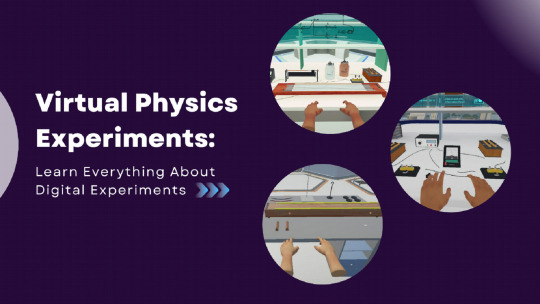
Physics is a fascinating subject that deals with nature’s basic laws. One of the best ways to learn physics is by doing experiments. Traditionally, students performed these experiments in a physical laboratory setting. This is where virtual physics experiments come in. Virtual physics experiments are computer simulations of real-world physics experiments.
In this blog, we will explore the world of virtual physics experiments. We will also delve into the benefits of using advanced digital physics simulations in the learning process.
Challenges and problems faced by students in physics laboratory

Before delving into virtual experiments, it is essential to understand the challenges that students often face in physical physics laboratories:
Limited Equipment Availability: Many schools and colleges have limited resources, resulting in inadequate equipment for conducting experiments. This scarcity often forces students to share equipment, limiting their hands-on experience.
Time Constraints: Physical labs often have strict time constraints. Students may have only a limited time to complete experiments, which can lead to rushed or incomplete observations.
Safety Concerns: Physics experiments can involve dangerous elements, such as high voltages or chemicals. Ensuring the safety of students in a physical lab is a constant concern for instructors.
Inadequate Supervision: In a crowded lab with limited instructors, it is challenging for each student to receive personalized guidance and supervision. This can hinder their understanding and ability to perform experiments correctly.
Equipment Malfunction: Mechanical and electrical equipment can malfunction, disrupting experiments and causing frustration for students.
Resource Constraints: Many schools struggle to maintain and upgrade their lab equipment due to budget constraints, leading to outdated or non-functional apparatus.
Benefits of advanced digital physics simulations

Now, let’s explore how advanced digital physics simulations address these challenges while offering numerous benefits:
Accessibility: Virtual experiments eliminate the constraints of physical laboratories, making them accessible to students regardless of their geographical location. This is especially beneficial for students in remote areas or those with limited access to laboratory facilities.
Safety: Dangerous experiments involving high voltages or hazardous materials can be simulated safely in a digital environment, reducing the risk to students and instructors.
Unlimited Resources: Virtual simulations provide an almost limitless array of resources and equipment, allowing students to perform experiments with various parameters and conditions, enhancing their understanding of underlying concepts.
Instant Feedback: In virtual experiments, students receive immediate feedback, enabling them to rectify mistakes and gain a deeper understanding of the experimental process.
Cost-Efficiency: Setting up and maintaining a physical laboratory can be expensive. Virtual experiments reduce costs associated with equipment, maintenance, and consumables.
Time Efficiency: Digital simulations save valuable class time that would otherwise be spent setting up and conducting experiments, allowing educators to cover more content.
Enhanced Visualization: Virtual experiments often come with advanced graphics and animations, making it easier for students to visualize complex physical phenomena.
Customization: Students can repeat experiments multiple times with different parameters, reinforcing their learning and experimentation skills.
How are these virtual physics experiments developed?
Ever wondered how these experiments are created? Creating digital and virtual physics experiments involves the application of various scientific principles and technologies to simulate physical phenomena and interactions in a computerized environment. Let’s know the science and development process behind digital and virtual physics experiments.
Understanding the Physics: Developers must have a deep understanding of the physics principles they want to simulate.
Mathematical Modelling: Physics simulations often begin with mathematical models that describe the behaviour of physical systems. These models use equations, such as Newton’s laws of motion or Maxwell’s equations for electromagnetism, to represent the underlying physics.
Programming Languages: Virtual physics experiments are implemented through computer programming using languages like C++, Python, or Java. These languages are chosen based on factors such as efficiency, platform compatibility, and ease of development.
Simulation Engines: Developers often use specialized simulation engines or libraries that provide tools and functions for modelling and solving physics problems efficiently. Examples include Unity for game-based simulations and libraries like OpenFOAM for fluid dynamics simulations.
Visualization
Rendering and Graphics: The visual representation of the virtual experiment is crucial. Developers use computer graphics techniques to render 2D or 3D simulations, including the use of shaders, textures, and lighting to create realistic visuals.
User Interface (UI): A user-friendly interface is designed to allow users to interact with and control the simulation. This includes features like menus, buttons, sliders, and data visualization tools.
User Input: Users interact with virtual physics experiments through input devices like a keyboard, mouse, or touchscreen. These inputs are translated into actions within the simulation, such as applying forces, changing parameters, or adjusting settings.
Real-Time Computation: Physics simulations must run in real-time, providing instantaneous feedback to users as they interact with the virtual experiment. Achieving real-time performance often requires optimizing code and using parallel computing techniques.
Accessibility and Educational Goals: Digital and virtual physics experiments are often developed with specific educational goals in mind. Developers must consider the target audience and design experiments that align with educational objectives
Integration with Hardware: In some cases, virtual physics experiments can be integrated with hardware devices like sensors, haptic feedback devices, or virtual reality (VR) headsets to enhance the user experience and provide more realistic interactions.
Experiments in the physics curriculum
Different state boards mandate a set of physics experiments for students. These experiments cover a wide range of topics, including mechanics, electricity, optics, and modern physics. There are many different virtual physics experiments available online. With virtual physics experiments, students can now access a vast repository of experiments that closely mimic real-world scenarios. Some of the most well-known are:
Simple Pendulum Experiment: This experiment allows students to study the period and frequency of a simple pendulum.
Ohm’s Law Experiment: By virtually connecting resistors, ammeters, and voltmeters, students can explore Ohm’s law and understand the relationship between voltage, current, and resistance.
Focal Length of Concave and Convex Mirror: Digital simulations allow students to adjust the object’s position and observe the corresponding image formed by the mirror, helping them understand the concepts of focal length and mirror behaviour.
Characteristics of a PN Junction Diode: Virtual experiments allow students to alter diode properties by adjusting the voltage and monitoring how it affects the flow of current, which aids in the understanding of semiconductor physics.
These are just a few examples of the many virtual physics experiments that are available. One of the most effective virtual science labs available in the market is SimuLab.
The most effective virtual experiment simulations and virtual lab – SimuLab
SimuLab is a 3D virtual scientific laboratory that enables students to study and conduct experiments – anytime, anywhere. It has the most advanced simulations of K-12 science subjects. SimuLab is an excellent tool for anyone who wants to experience real experiments or learn more about science. It is a cutting-edge learning tool created by IITians using modern technologies such as AI, AR, and VR.
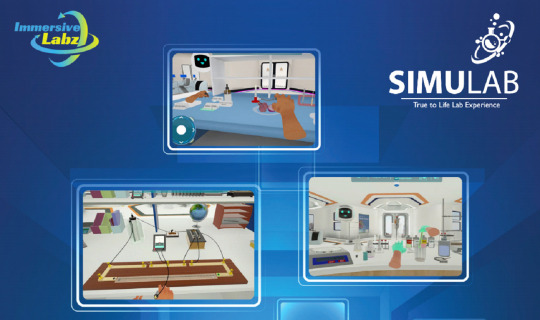
Overview:
Easily access the science laboratory with convenience and without any difficulties.
Acquire a simplified and engaging method to learn scientific experiments.
Receive comprehensive, step-by-step instructions for conducting experiments.
Foster the development of scientific reasoning and a strong conceptual grasp of the subject.
Practice experiments an unlimited number of times.
Retain a deep understanding of scientific concepts over an extended period.
Achieve improved academic performance and excel in competitive exams such as IIT/NEET.
Access the platform effortlessly across various devices, including smartphone, desktop, and tablet.
About virtual simulations:
Abundant resources are available to facilitate a comprehensive understanding of each science experiment.
Aim: Establishes a clear focus on the experiment’s purpose and objectives.
Objective: Outlines what will be taught, how it will be learned, and what outcomes can be expected from the experiment.
Safety Precautions: Provides safety guidelines specific to each experiment to ensure a secure laboratory environment.
Theory: Offers simplified theoretical explanations to aid learners in grasping fundamental concepts.
Story: Incorporates real-life scenarios related to the subject to enhance engagement in the learning process.
Simulation: Grants access to an advanced virtual platform for conducting science experiments.
Quizzes: Includes multiple quiz questions to facilitate better preparation for competitive exams like IIT/NEET.
Analytics: Allows users to assess their progress and monitor overall progress using a performance dashboard.

Final words
Virtual physics experiments have transformed the way students learn and understand physics concepts. For students, these simulations offer a comprehensive and efficient way to conduct experiments while addressing the challenges faced in physical laboratories. Embracing virtual physics experiments not only keeps students engaged but also prepares them for a world where technology plays an ever-increasing role in scientific research and experimentation.
Writer – Girish Hedau
Scientific Content Writer – Physics
1 note
·
View note
Text
Virtual Physics Experiments: Learn Everything About Digital Experiments
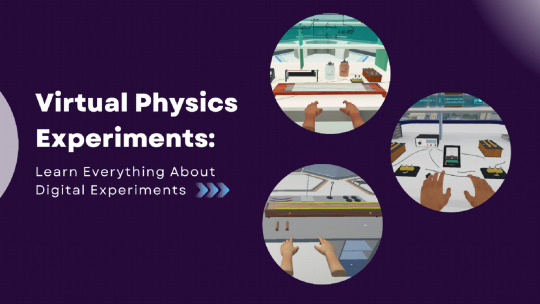
Physics is a fascinating subject that deals with nature’s basic laws. One of the best ways to learn physics is by doing experiments. Traditionally, students performed these experiments in a physical laboratory setting. This is where virtual physics experiments come in. Virtual physics experiments are computer simulations of real-world physics experiments.
In this blog, we will explore the world of virtual physics experiments. We will also delve into the benefits of using advanced digital physics simulations in the learning process.
Challenges and problems faced by students in physics laboratory

Before delving into virtual experiments, it is essential to understand the challenges that students often face in physical physics laboratories:
Limited Equipment Availability: Many schools and colleges have limited resources, resulting in inadequate equipment for conducting experiments. This scarcity often forces students to share equipment, limiting their hands-on experience.
Time Constraints: Physical labs often have strict time constraints. Students may have only a limited time to complete experiments, which can lead to rushed or incomplete observations.
Safety Concerns: Physics experiments can involve dangerous elements, such as high voltages or chemicals. Ensuring the safety of students in a physical lab is a constant concern for instructors.
Inadequate Supervision: In a crowded lab with limited instructors, it is challenging for each student to receive personalized guidance and supervision. This can hinder their understanding and ability to perform experiments correctly.
Equipment Malfunction: Mechanical and electrical equipment can malfunction, disrupting experiments and causing frustration for students.
Resource Constraints: Many schools struggle to maintain and upgrade their lab equipment due to budget constraints, leading to outdated or non-functional apparatus.
Benefits of advanced digital physics simulations

Now, let’s explore how advanced digital physics simulations address these challenges while offering numerous benefits:
Accessibility: Virtual experiments eliminate the constraints of physical laboratories, making them accessible to students regardless of their geographical location. This is especially beneficial for students in remote areas or those with limited access to laboratory facilities.
Safety: Dangerous experiments involving high voltages or hazardous materials can be simulated safely in a digital environment, reducing the risk to students and instructors.
Unlimited Resources: Virtual simulations provide an almost limitless array of resources and equipment, allowing students to perform experiments with various parameters and conditions, enhancing their understanding of underlying concepts.
Instant Feedback: In virtual experiments, students receive immediate feedback, enabling them to rectify mistakes and gain a deeper understanding of the experimental process.
Cost-Efficiency: Setting up and maintaining a physical laboratory can be expensive. Virtual experiments reduce costs associated with equipment, maintenance, and consumables.
Time Efficiency: Digital simulations save valuable class time that would otherwise be spent setting up and conducting experiments, allowing educators to cover more content.
Enhanced Visualization: Virtual experiments often come with advanced graphics and animations, making it easier for students to visualize complex physical phenomena.
Customization: Students can repeat experiments multiple times with different parameters, reinforcing their learning and experimentation skills.
How are these virtual physics experiments developed?
Ever wondered how these experiments are created? Creating digital and virtual physics experiments involves the application of various scientific principles and technologies to simulate physical phenomena and interactions in a computerized environment. Let’s know the science and development process behind digital and virtual physics experiments.
Understanding the Physics: Developers must have a deep understanding of the physics principles they want to simulate.
Mathematical Modelling: Physics simulations often begin with mathematical models that describe the behaviour of physical systems. These models use equations, such as Newton’s laws of motion or Maxwell’s equations for electromagnetism, to represent the underlying physics.
Programming Languages: Virtual physics experiments are implemented through computer programming using languages like C++, Python, or Java. These languages are chosen based on factors such as efficiency, platform compatibility, and ease of development.
Simulation Engines: Developers often use specialized simulation engines or libraries that provide tools and functions for modelling and solving physics problems efficiently. Examples include Unity for game-based simulations and libraries like OpenFOAM for fluid dynamics simulations.
Visualization
Rendering and Graphics: The visual representation of the virtual experiment is crucial. Developers use computer graphics techniques to render 2D or 3D simulations, including the use of shaders, textures, and lighting to create realistic visuals.
User Interface (UI): A user-friendly interface is designed to allow users to interact with and control the simulation. This includes features like menus, buttons, sliders, and data visualization tools.
User Input: Users interact with virtual physics experiments through input devices like a keyboard, mouse, or touchscreen. These inputs are translated into actions within the simulation, such as applying forces, changing parameters, or adjusting settings.
Real-Time Computation: Physics simulations must run in real-time, providing instantaneous feedback to users as they interact with the virtual experiment. Achieving real-time performance often requires optimizing code and using parallel computing techniques.
Accessibility and Educational Goals: Digital and virtual physics experiments are often developed with specific educational goals in mind. Developers must consider the target audience and design experiments that align with educational objectives
Integration with Hardware: In some cases, virtual physics experiments can be integrated with hardware devices like sensors, haptic feedback devices, or virtual reality (VR) headsets to enhance the user experience and provide more realistic interactions.
Experiments in the physics curriculum
Different state boards mandate a set of physics experiments for students. These experiments cover a wide range of topics, including mechanics, electricity, optics, and modern physics. There are many different virtual physics experiments available online. With virtual physics experiments, students can now access a vast repository of experiments that closely mimic real-world scenarios. Some of the most well-known are:
Simple Pendulum Experiment: This experiment allows students to study the period and frequency of a simple pendulum.
Ohm’s Law Experiment: By virtually connecting resistors, ammeters, and voltmeters, students can explore Ohm’s law and understand the relationship between voltage, current, and resistance.
Focal Length of Concave and Convex Mirror: Digital simulations allow students to adjust the object’s position and observe the corresponding image formed by the mirror, helping them understand the concepts of focal length and mirror behaviour.
Characteristics of a PN Junction Diode: Virtual experiments allow students to alter diode properties by adjusting the voltage and monitoring how it affects the flow of current, which aids in the understanding of semiconductor physics.
These are just a few examples of the many virtual physics experiments that are available. One of the most effective virtual science labs available in the market is SimuLab.
The most effective virtual experiment simulations and virtual lab – SimuLab
SimuLab is a 3D virtual scientific laboratory that enables students to study and conduct experiments – anytime, anywhere. It has the most advanced simulations of K-12 science subjects. SimuLab is an excellent tool for anyone who wants to experience real experiments or learn more about science. It is a cutting-edge learning tool created by IITians using modern technologies such as AI, AR, and VR.
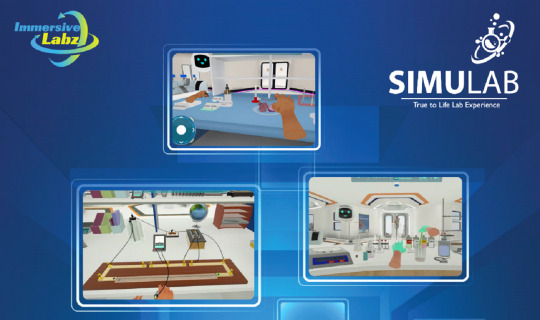
Overview:
Easily access the science laboratory with convenience and without any difficulties.
Acquire a simplified and engaging method to learn scientific experiments.
Receive comprehensive, step-by-step instructions for conducting experiments.
Foster the development of scientific reasoning and a strong conceptual grasp of the subject.
Practice experiments an unlimited number of times.
Retain a deep understanding of scientific concepts over an extended period.
Achieve improved academic performance and excel in competitive exams such as IIT/NEET.
Access the platform effortlessly across various devices, including smartphone, desktop, and tablet.
About virtual simulations:
Abundant resources are available to facilitate a comprehensive understanding of each science experiment.
Aim: Establishes a clear focus on the experiment’s purpose and objectives.
Objective: Outlines what will be taught, how it will be learned, and what outcomes can be expected from the experiment.
Safety Precautions: Provides safety guidelines specific to each experiment to ensure a secure laboratory environment.
Theory: Offers simplified theoretical explanations to aid learners in grasping fundamental concepts.
Story: Incorporates real-life scenarios related to the subject to enhance engagement in the learning process.
Simulation: Grants access to an advanced virtual platform for conducting science experiments.
Quizzes: Includes multiple quiz questions to facilitate better preparation for competitive exams like IIT/NEET.
Analytics: Allows users to assess their progress and monitor overall progress using a performance dashboard.

Final words
Virtual physics experiments have transformed the way students learn and understand physics concepts. For students, these simulations offer a comprehensive and efficient way to conduct experiments while addressing the challenges faced in physical laboratories. Embracing virtual physics experiments not only keeps students engaged but also prepares them for a world where technology plays an ever-increasing role in scientific research and experimentation.
Writer – Girish Hedau
Scientific Content Writer – Physics
0 notes
Text
“reality is merely an illusion, albeit a very persistent one.”
~Albert Einstein
#albert einstein#quotes#light#consciousness#simulated universe#holographic universe#virtual reality#manifestation#alchemy#ascension#energy#magic#godhood#esoteric#manifesting#science#enlightenment#meditation#spiritual awakening#spiritual awareness#spirit#quantum physics#quantum mechanics#double slit experiment
266 notes
·
View notes
Text
2 weeks on buproprion tomorrow ... feeling normal .. suspicious. Going down on my lexapro as well. I do feel a bit different from that lol but its very subtle i feel. Not rlly gonna be noticing much until its a few months in
#everybody clap for me ive been scared of changing meds for 10 years bcs of poor experiences#ive just been so kicked in the ass with fatigue forever that i was just like im. i cannot live like this#fatigue/irritation#lol tumblr showing me the popular tags featuring the words chronic fatigue thanks yall#caffeine has been the only thing making my body do things otherwise its just force#i think i am also like. mentally fatigued much more than physically#like i cannot find interest in doing things that would benefit me its almost annoying to think about#feeding myself has been a STRUGGLE for a long time but im doing a lot better with it#this is my virtual diary#coffee talk
2 notes
·
View notes
Text
Why Dencity is the Best Online Science Experiment App for Students
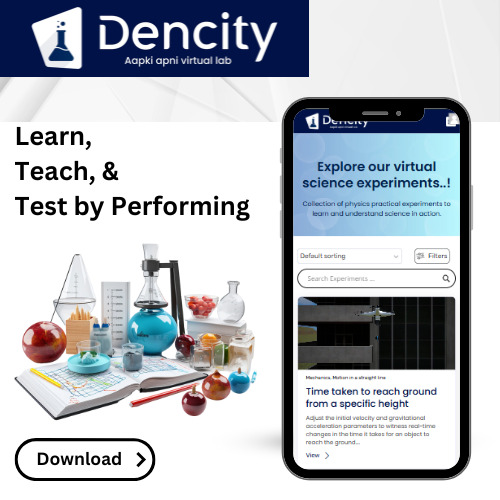
Science experiments play a crucial role in understanding concepts beyond textbooks. However, limited lab resources, safety concerns, and accessibility issues often hinder students' learning experience. That’s where Dencity, the best science experiment app, bridges the gap by providing an interactive online lab for students.
Dencity App: The Ultimate Science Experiment Platform
Dencity is a next-gen experiment app designed to make science experiments accessible anytime, anywhere. With features like customizable 3D views, step-by-step calculations, and virtual group experiments, students can grasp concepts effectively without needing a physical lab.
Key Features of Dencity
Modify Parameters for Deeper Understanding
Change experiment variables and observe different outcomes in real-time.
Helps students understand cause-and-effect relationships in physics.
Step-by-Step Calculations
Breaks down complex physics problems into easy-to-understand steps.
Aligned with school curriculum to assist students with learning.
Customizable 3D View
Rotate, zoom, and switch angles to explore physics experiments from different perspectives.
Enhances visual learning for a better understanding of scientific phenomena.
Interactive Whiteboard & Drawing Tools
Teachers can draw, annotate, and explain concepts interactively.
Ideal for online classrooms and live discussions.
Homework & Submissions
Teachers can assign science experiments as homework in seconds.
Students can submit assignments and track progress effortlessly.
Group Experiments & Live Collaboration
Allows students and teachers to collaborate on science experiments remotely.
Teachers can hand over control to students for an interactive learning experience.
Safe & Risk-Free Learning Environment
Perform hazardous or complex experiments safely in a virtual science lab.
Eliminates risks associated with physical lab experiments.
Applications of Dencity in Science Education
✅ Enhancing Classroom Learning – Supports both in-person and remote science education. ✅ Self-Paced Learning – Students can explore science experiments independently at their own pace. ✅ Teacher-Friendly Features – Homework, submissions, and group experiments streamline teaching. ✅ Bridging the Lab Accessibility Gap – Makes science practical available to students worldwide.
Conclusion
Dencity is more than just an app for physics experiments—it’s a complete virtual lab that empowers students to explore, experiment, and understand science in a whole new way. Whether in school, at home, or on the go, Dencity revolutionizes how science is taught and learned.
#Science Experiment#Experiment App#App for Physics Experiments#Virtual Science Experiments#Science Experiment App#physics practical experiments#physics experiment app
1 note
·
View note
Text
last therapy session for a bit
#mine#talked abt the move and stuff#maybe next year my goal will be driving idk#physically I'm iffy but only sometimes yanno#sometimes is rn btw ow#anyway if I choose to resume it'll be over zoom or something#therapist pointed out the irony of how much we both hate virtual meetings#I'll see how I feel in three weeks or so#lem experiences cognitive behavioural torture
4 notes
·
View notes
Text
AJR was right. It really doesn't seem like there's anyone for me
#not talking romance even btw. although sure yeah that too. but.#I don't know. 28 years without the kind of friendships where you casually hang out a lot#without a social network that you can see weekly.#it's not that I don't appreciate online and farther away friends. it's not. god knows they are my lifeline#but I can feel my heart growing a little more tired and a little colder every so on#and look. I go to activities and have some groups I genuinely enjoy being in#but it has to be said there are 0 individual bonds with anyone there. I enjoy the environment and physical presence of the group#but I can't call any one individual a friend. and that is hard#I know people say to find activities for shared interests and I'm sure some people find friends that way#and I have fun and new experiences but I don't. make friends. like it just doesn't happen#I don't know. I feel like I might as well wander through life as a ghost. virtually impactless#and it's fine. I'll wander through life. I'll travel to experience temporary kinship. all along I'll feel sorrow at the prospect of leaving#but in the end I will come home to an empty house and that is where one day I will die#it's just how it is. it's how it's always been. at a certain point you can't really ask for that miraculous turnaround in life anymore#nothing is going to magically shift. not when life time and time again grabs you and says this is who I am for you#you can wish and wait and hope and it will never ever be anything but this#bien rambles
6 notes
·
View notes
Text
AR & VR App Development Services | Aquil Tech Labs

We specialize in creating immersive Augmented and Virtual Reality experiences that connect the physical and digital worlds—perfect for interactive training, virtual simulations, marketing activations, and beyond. Our expert team handles everything from hardware integration to software optimization, ensuring smooth, cost-effective execution. Whether you're developing an AR app, a VR walkthrough, or an engaging demo, we deliver high-impact results—on time and within budget. Partner with us to boost user engagement, enhance brand interaction, and future-proof your business in today’s tech-driven market.
Phone : +91 9970038903
0 notes
Text
Experience Minecraft: Real-Life Theme Park Adventures
By Alice Have you ever wished you could step inside Minecraft for real? Imagine walking through a village, dodging creepers in a dark forest, or riding a roller coaster through a Nether portal! Well, hold onto your pickaxes, because Minecraft is leaping from the screen into real-life theme parks! Big news: Minecraft is teaming up with entertainment giants like Merlin Entertainments and other…
#AI in theme parks#AI-driven storytelling#augmented reality theme parks#digital and physical reality merge#future amusement park trends#future of gaming#games#gamification in amusement parks#gaming#gaming meets real world#gaming-inspired attractions#haptic feedback in theme parks#immersive theme parks#interactive entertainment#interactive gaming experiences#minecraft#Minecraft theme park#Pokémon theme park#Roblox theme park#theme park technology#travel#video game theme parks#video-games#virtual reality theme parks#Zelda theme park
0 notes
Text
🎊 Dive into the excitement with Super Mario Party Jamboree—available now! 🎮 With 22 characters and over 110 hilarious minigames, this is the biggest party game in the Mario series! 🥳 Whether you’re gaming with friends locally or online, every party will be unforgettable!
And here's a bonus: Pre-order or buy before March 31, 2025, for a 3-month Nintendo Switch Online membership! 💌
Unleash the party spirit today!
#Super Mario Party#Mario Party Jamboree#Nintendo Switch#Party Games#Minigames#Family Games#Gaming With Friends#Online Gaming#Video Game Night#Multiplayer Games#Nintendo Games#Game Night#Fun With Friends#Board Games#Party Mode#Gaming Community#Coop Games#Teamwork Fun#Competitive Gaming#Game Modes#Character Selection#Gaming Experience#Nintendo Online#Switch Games#Gaming Adventure#Physical Games#Virtual Parties#Game Review#New Game Release#Fun Times
1 note
·
View note
Text

Are traditional labs holding back your physics teaching and classroom progress?
PraxiLabs Virtual Labs offers a game-changing solution: ✔️Elevate your Physics Curriculum ✔️Overcome Lab Limitations ✔️Enhance Student Learning
Discover how to overcome the obstacles of the Free Fall experiment in physics.
0 notes
Text
How is gamification impacting today’s modern education?

What is gamification?
Gamification in education is the process of incorporating game-like elements into the learning experience. The main goal of gamification is to make learning more engaging and enjoyable while promoting the development of key skills such as problem-solving, critical thinking, and collaboration. Gamification can take many forms, from simple educational games to complex, multi-player simulations. In this blog, we’ll explore the role of gamification in education and its potential benefits.

What are their benefits?
One of the main benefits of gamification in education is increased engagement. By making learning feel more like a game, students are more likely to be actively involved in the learning process.
This increased engagement can lead to improved retention of information and a greater sense of accomplishment. For example, a student who is highly engaged in a game-like learning experience is more likely to remember the information they have learned than a student who is simply listening to a lecture or reading a textbook.
Another benefit of gamification in education is that it promotes the development of key skills. By playing educational games, students are given the opportunity to develop critical thinking and problem-solving skills. This type of learning is much more effective than traditional methods, as students can apply the information they have learned in real-world scenarios. This leads to a deeper understanding of the material and the development of long-term retention of information.

Gamification can also help to break down barriers in the classroom. For example, students who may not be confident in a traditional learning environment may feel more comfortable participating in a game-like setting. By breaking down these barriers, students can take an active role in their own learning and develop a sense of pride in their achievements.
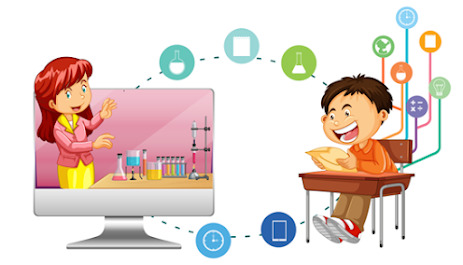
Another advantage of gamification in education is that it can provide a fun and engaging way for students to learn. This is especially important in today’s world, where students are often exposed to a barrage of digital distractions and are in need of more interactive and engaging learning experiences. Gamification can help to keep students engaged and motivated, even when they are facing difficult material.
Finally, gamification can be used to create a more personalised learning experience. By tracking the progress of individual students and adapting the learning experience to their needs, gamification can provide a more tailored experience that is tailored to each student’s strengths and weaknesses. This can help to ensure that each student is challenged at the right level and is motivated to continue learning.
Conclusion
Gamification in education has the potential to transform the way we approach learning. By making learning more engaging and enjoyable, gamification can help to increase engagement, promote the development of key skills, break down barriers in the classroom, provide a fun and engaging way to learn, and create a more personalized learning experience. It is an innovative approach that has the potential to revolutionise the way we approach education in the future.
Writer – Irshad Girach
Unity Developer
#immersivelabz#virtual science lab#science experiments#simulab#virtual chemistry experiments#virtual biology experiments#Virtual Physics Experiments
1 note
·
View note
Text
Real_b
#1. Real_b technology#2. Augmented reality blending#3. Virtual and physical integration#4. Immersive digital experiences#5. Real_b applications#6. Real_b challenges#7. Future of real_b#8. Real_b in gaming#9. Real_b in education#10. Ethical considerations in real_b
1 note
·
View note
Text
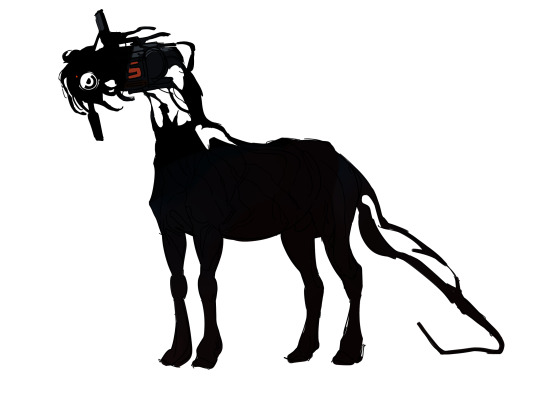
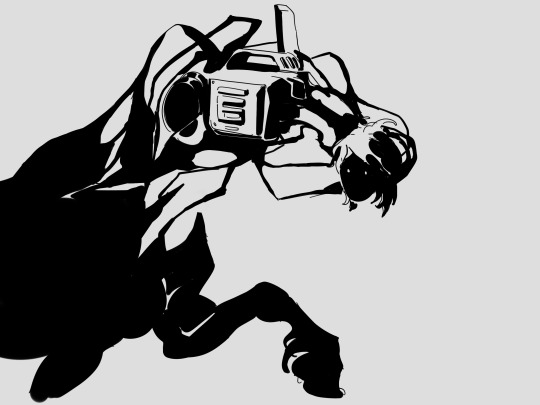
Camera & Action in their own original concept sketches. these were on my other blog but since ppl seem to enjoy the designs i thought i'd have them here as well
ppl may already know that pascal is no longer in the canon of inver, i decided to make a new story :)
so it's about these pseudo-AI assistant/virtual creatures called imimata (singular: imimaton). In the context of the story it's specifically about celebrity culture, virtual pop stars/TV presenters, and labour relations
[copy-pasted explanation from the other blog lol but i have a tag for it here too with a lot more posts!!]
Think of a completely formless seed that, for a fleeting moment, has the potential to become an artificial intelligence, but always changing, with endless permutations and no permanent state of being. when kept within a resonance chamber (the ‘container’ that may be analogue or digital etc), it is fixed into place long enough for it to be able to become. the chamber holds it and allows it to develop instead of dissipate away instantly. the process of development led by external forces - intentional or unintentional - is called 'encoding’. professional encoders will essentially use this shapeless state of being to encode commands, personality prompts, and rules, essentially moulding the thing in the resonance chamber into a form dictated by them. when i say unintentional, i also mean that exposure to any stimulus will always be a learning experience, and the thing will grow and develop no matter what if it first gets fixed in one place. but it’s only referred to as an imimaton once it has been encoded - no longer raw matter, but hammered into shape.
encoding is basically the socialisation of an impressionable thing into a biddable and useful form. in the early Hertzian era (when this technology took off, 1830s ish - crucially, before the commercial application of imimata, when they were curious playthings for idle Great Thinkers), encoding was a process of conversation lasting many years, often for purely philosophical purposes, literally talking at something until it talked back. prior to this, natural magnets could be used to fix a proto-imimaton, and people would think of them as similar to homunculi. in today's digital era, encoding takes the form of inserting storage media into the chamber, essentially running a program in a computer that reduced the encoding process to a few seconds and the flip of a switch. Pascal is an example of a Hertzian imimaton, composed of information stored in radio waves rather than a digital storage medium (basically - he's analogue)
outside of encoding, clauses may be placed upon the chamber itself and these are less socialisation, they do not form the building blocks of an imimaton, they are purely strict rules and routines which it is bound to follow. one such clause could involve the censorship of certain words (so that an imimaton cannot say fuck even if they would otherwise have been able to), or strict boundaries on what information an imimaton is allowed to learn. a common clause also boils down to making it impossible for one to attempt to manifest physically.
Once this was perfected, imimata entered the workforce at the turn of the 20th century.
[...]
When Pascal made his TV debut in 1969, it was hyped up for months with ads which depicted him on set and in more realistic ways (almost appearing to be photographs - some even were!), while public reaction was carefully monitored. This was highly experimental and it still was not known whether the concept of a virtual TV presenter worked, so although they did hype it up, there was a level of caution too so as not to invite negative press.
The first series did not involve public audience members but people from the broadcasting studio standing in for them (this was not made known at the time). They used a combination of camera tricks and graphics to make it feel like he was physically standing in a room with these people (bearing in mind he was strictly contained and had no manifestation outside the broadcast - he was within a container at the base of the mast tower, with a recording device which could cast his image live, so viewers at home were seeing cuts of the Pascal feed and cuts of the physical studio and audience stitched together to appear continuous)
That was part of the gimmick - it was commonly felt that an imimaton should never be permitted to manifest/should have no manifestation, so the fact that he supposedly was manifesting but friendly and contained was a draw. the ads leaned into it quite a lot - marketing copy implying that you could touch him, go on dates with him, etc but always with a cheeky wink, a "not really", the audience at home were in on the secret of it not being real. but it worked really well and was super effective to generate hype and it sparked an entire golden era of imimata and manufactured celebrities (but Pascal remained notorious for being one of the only ones that could believably interact with a studio audience in an unscripted manner, due to his 'maturity' as an imimaton, having been brought up in the 19th century conversational era of encoding, raised on a diet of talking to philosophers)
The second season of the show came out quickly and to much anticipation, and with members of the public actually participating for the first time. The broadcasters set up a wall of CRTs in the studio which would display him to people on-set, and wired up each audience member with a microphone so he could hear them too (he appeared to see them well enough through the camera equipment). he was excited to interact with them and they liked him too, but he always had this slightly mean streak which his broadcaster tried hard to soften. but the meanness worked really well in the reality/game show format where half the entertainment is watching audience members get dunked on sometimes
Episodes could be produced at a rapid pace by taping multiple at once - three identical sets were built for season 3 allowing for three episodes to be filmed at once because he could of course interact with everyone freely and essentially be in multiple places at once. this was also where the first issues showed up on-set - he began to miss his timing cues, arriving just a bit too late to the stage, or taking slightly too long to finish his nightly sign-off. this was not apparent publicly as the episodes were not shown live and could be edited, but any member of the public who was on the show was often hounded after by superfans, so some stories did come out about Pascal's 'odd' behaviour on set. there was a behind-the-scenes documentary made about the entire producing process in season 3 as well, which included some interviews with Pascal himself, but mostly consisted of his handlers and technicians excitedly explaining the broadcast apparatus and containment devices and so on.
Following The Incident, the rare copies of this film became highly sought-after by collectors.
#(calling the horseys separate names is just a joke. they are all pascal)#imimata rampant#Unicorn is also in this story too :) he is a digital pop star who debuted in 2003 and looks like a y2k fan's wet dream
1K notes
·
View notes
Text
Explore Science with the Physics Experiment App

Conduct real-time experiments with the Physics Experiment App, designed for students and educators. This interactive Physics App brings scientific concepts to life through engaging simulations. Experience hands-on learning with our Science App, featuring a Virtual Lab that lets you explore physics without the need for physical equipment. Enhance your understanding of motion, energy, and forces in a fun and immersive way. Download the Physics Experiment App today and revolutionize your science learning!
0 notes
Text
Virtual DashCon 2
When I first heard the news that DashCon had been resurrected, I was thrilled. I followed the news and counted down the days. By the time tickets became available, I knew I couldn't travel to Canada due to my personal circumstance. Thankfully, there were virtual tickets for sale! I got to see live events and listen to virtual panels on Discord.
I didn't catch every single panel or thing that happened, but here's a quick rundown of my DashCon 2 experience:
Watched the Opening Ceremony featuring the con organizers.
Ball Pit.
Learned about the origins of Nico the Catboy and his rise to Tumblr fame.
DashCon 2 Intern face reveal, along with the backstory of DashCon 2's conception.
Plinko Horse.
Watched a virtual panel about how fan websites are created.
Missed the cosplay contest because I was ordering a pizza. Got to see the winners announced. According to the wizard, the spirit of DashCon is balls.
Heard Strange Aeons speak about internet archive reporting and preservation.
Witnessed Strange Aeons kill Muppet Joker (aka the Croaker) live on stream.
The Musical InterDudes sang "Man or Muppet" in memoriam. They held up letters spelling out "Kung Pow Penis" before said performance.
Attended a virtual panel discussing fanfic writing as an adult, how this affects your writing and how to juggle the hobby.
Tumblr Sexyman Shrine.
Learned all about raccoons and conservation surrounding them from the og DashCon creator in a rabiosexual themed panel.
Watched all of the Doctors go on trial for their crimes against the time lords.
Learned about the importance and intersectionality surrounding queer healthcare.
Watched "Bloody Heartss" and a discussion with the creator afterwards.
Watched the raffle giveaway. Prizes included signed ball pit balls and books. The plinko horses (Orb, Horb, and Charlie) were given away in the most popular raffle of the evening.
Two people won an extra hour in the ball pit.
There were two (three??) engagements at DashCon 2.
Today was DashMom's (organizer's mom) birthday. Everyone sang "Happy Birthday" to her.
Strange Aeons was knighted by Queen Ball Pit Lochlan O'Neil.
Listened in on a virtual panel discussing AO3 basics and tips.
"My Immortal" Kahoot, 60 questions. Everyone in attendance was declared goth. The winner won a physical copy of the fic.
Watched a virtual panel about how fanfiction has evolved alongside the ever-changing internet landscape.
Watched a virtual panel about media analysis and engaging with people's opinions on the internet. (This one was my favorite!)
Despite not being there in person, I had so much fun today! Everyone both online and in-person were in on the joke, respectful and encouraging. From where I stand, the event was well organized, accommodating, and a safe space for everyone there. I haven't seen many cons, but was impressed by this one. If the organizers decide to host DashCon 3, I'd for sure want to go!
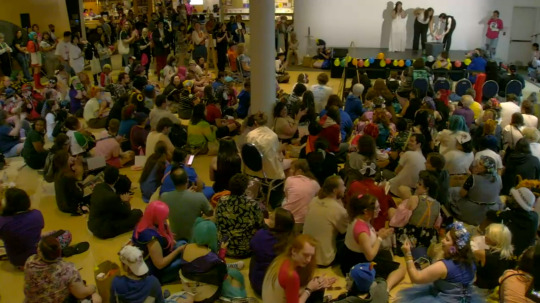
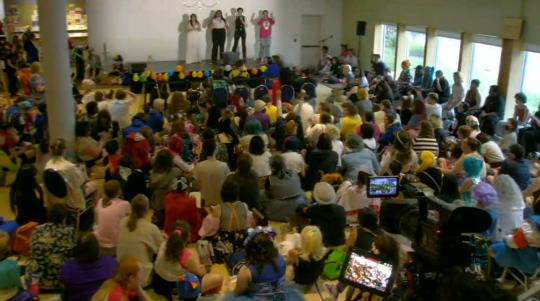
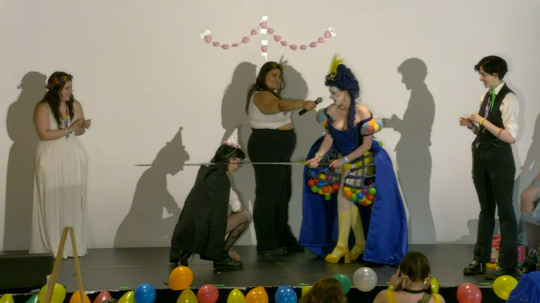
1K notes
·
View notes